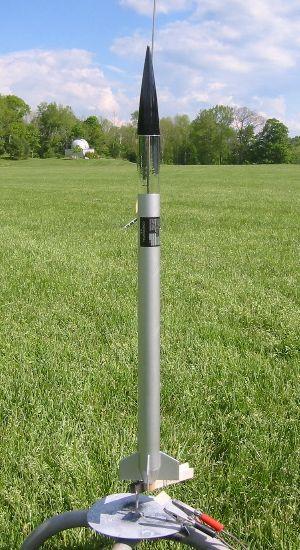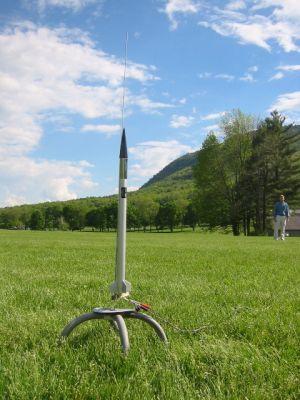
Brief:
A 4.6:1 scale model of the famous Arcas research rocket. This kit is an excellent introduction to scale model rocketry. Not only does the builder gain skills in the construction of the Arcas, but one ends of with a great flying model rocket that is very inexpensive as well.
Construction:
The parts list:
- engine tube
- engine block ring
- adapter rings
- pattern sheet for boat tail
- body tube (1" x 15")
- laser cut basswood fins
- launch lug
- shock cord mount and shock cord
- balsa nose cone
- screw eye
- parachute with shroud lines
- adhesive chrome sheet
- decal
I don't know if these kits are available elsewhere, but I picked up my Alway Arcas from Balsa Machining Services. I wanted to make a Goblin and Der Red Max and decided to get an Arcas as well. The Alway instructions are some of the best instructions I have seen out there: plenty of illustrations, scale information, and step by step instructions to build a great scale rocket.
Assembly is pretty easy. First, I began with the motor mount gluing in the thrust ring and then adding an adapter ring at the bottom. The builder is instructed to cut out a boat tail shroud on the provided cardstock and then create the boat tail, which is then glued on to the bottom of the motor mount. Afterwards, the forward adapter is glued flush with the top of the motor mount. The motor mount is then glued into the body tube.
Next, I removed the laser cut fins from the basswood sheet, sanded them smooth, and rounded the edges. I marked four lines on the body tube 90 degrees apart and glued the fins on, making sure I added fillets.
Peter Alway's kit uses the tri-fold method for securing the shock cord to the body tube. The only change I made to my construction of the Arcas was to add Kevlar to the shock cord.
Then comes the nose cone. The instructions say how to add yellow glue to the nose cone not only to seal it but also to create a smooth finish to the nose cone. I must have put on 5 or 6 thin layers on my nose cone until I was pleased with the results. I then sanded the nose cone with 200 grit sandpaper and then 400 grit. I used CA glue to add the screw eye to the nose cone.
The parachute that comes with the kit is nice and bright. I had to cut out the plastic parachute from the printed pink "garbage bag" plastic and then add the included shroud lines. Not too difficult so far.
I added the launch lug last before finishing the rocket.
Finishing:
I used Elmer's Fill 'n' Finish to seal the body tube and fins and then covered the rocket with primer. The nose cone required some sanding with medium grit sandpaper followed by fine sandpaper before priming. After sanding, priming, and sanding, I painted the nose cone black and the body an aluminum/silver color.
After the paint cured, I put on the Monokote-like silver adhesive at the top of the body tube, then added the one high quality decal one inch below the silver MonoKote.
I then sealed the decal with Microscale's Micro-Sol, which is a decal softening solution, and Microset.
After this was dry, I gave the rocket a coating of Future Floor Finish. The rocket looked nice when done although I realized after painting that I didn't get all the grooves filled in the body tube. Oh, well, you can't win them all.
Construction Rating: 4 out of 5

Flight:
Flying was a great success. The motor has to be friction fit since there is no motor hook. After a few sheets of wadding, the parachute is folded and placed inside. I flew the rocket twice, both times on the same afternoon in 10-15 mph winds, thus I elected only to fly with 1/2A3-4T motors.
Both flights were wonderful and it was very stable, straight, and nice boost on the 1/2A. Parachute opened perfectly at apogee both times and the rocket landed safely and softly. The next time I am launching and there is no wind, I will try the A3-4T.
This makes a great small field flyer on the 1/2As and if the weather cooperates, you might even be able to launch it on an A3 or A10.
Recovery:
The parachute is plastic but good quality like a Semroc or FlisKits plastic parachute. The kit also comes with a swivel, so there is little tangling of the lines. I found the parachute to be the perfect size for this rocket.
Flight Rating: 5 out of 5
Summary:
This is a cool, sleek rocket that is a simple build. I am getting more interested in scale model rocketry and I like the quality of the kit. I did look in Alway's book, Rockets of the World and realized there is a fin detail in the drawing of the book that is not included in the kit. I think any seasoned builder could probably alter and add the detail needed to take the scale modeling one step further.
At first when I saw the size of the rocket, I thought the 13 mm motor mount would be too small for it. I was surprised and delighted to figure out that this is a great flyer and that it doesn't need any more power than a 13mm motor.
Overall Rating: 4 out of 5








D.K.B. (May 29, 2010)